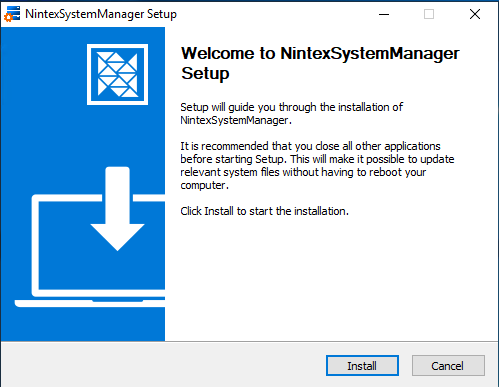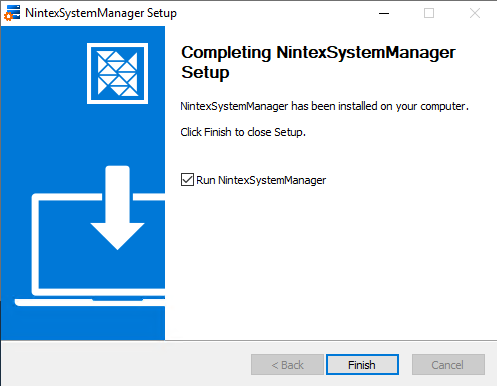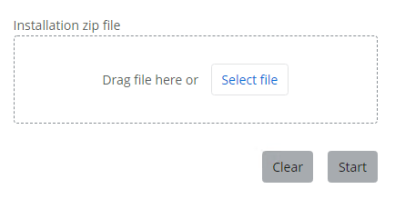RPA server GUI installation
Currently, you cannot uninstall the RPA Server through the System Manager's GUI installer. However, you can uninstall using the Uninstallation process.
Nintex System Manager provides a comprehensive solution for managing the installation of RPA. The following sections are relevant information related to the process.
Perform the following actions before starting the installation:
Before you start, create a restore point for the server VM.
- Disable any anti-virus software that is running to improve the installation performance.
- Ensure that you have installed the latest version of Nintex System Manager (Nintex RPA) (
NintexSystemManagerSetup.exe). -
Check server requirements according to Nintex RPA server.
- Ensure that the latest version of the RPA installation bundle zip file (e.g.,
nintex-rpa-server-<latest version>-full.zip) is ready and available for use during the upgrade process. -
Verify that no conflicting versions of .NET are present in the PATH environment variable. See Known issues below.
-
Database-related items:
-
Ensure the user account that will run the installation process is able to log in to the MSSQL Server.
-
The user account should have the Server role
sysadminfor the MSSQL Server.If the RPA and MSSQL servers are installed on different machines, you must establish an open connection between both servers to ensure optimal functionality.
-
-
Authentication-related items:
-
(For TLS/SSL installation) Different certificate file options, such as Personal Information Exchange file (e.g.,
kryonaws_full_chain.pfxor PKCS#12), CERT, KEY, and PEM files, are supported. Ensure you have the necessary files for your environment and that each server in a multi-server installation has a certificate installed prior to the upgrade process.
-
The primary method of installing RPA is through System Manager, which provides a user-friendly graphical interface.
To install System Manager, follow these steps:
-
Locate and run the System Manager executable file:
NintexSystemManagerSetup.exe. -
Click Install.

-
(Optional) Select the Run NintexSystemManager checkbox to launch the application immediately after installation.

-
Click Finish.
After installing System Manager, you can run it. It will guide you through the RPA installation process. The System Manager GUI guides you through the following steps:
| Page | Description |
|---|---|
| Welcome | Page to select the ZIP file that you want. |
| Setup | Page used to enter server details and specify the desired destination folder. |
| System check | Verifies that your system meets the requirements for the software. |
| Configurations | Page to configure the preferred connection option and specify the desired port. |
| Optional features | Page to enable or disable key features. |
| Third parties | Page to configure settings for various external components used in the system. |
| Install | Page that shows the progress of the procedure. |
| Completion | Indicates the successful completion of the process. Choose to launch the System Manager immediately or exit the installer. |
When System Manager starts, do the following:
-
Drag the RPA installation bundle ZIP (.zip) file into the designated box or select the ZIP file by clicking Select file.

-
Click Start to begin the installation process.
> Next step: Setup
Following are recommended actions after you have performed the installation:
-
Proceed with the Client installation (Studio and Robot).
-
Run the Dynamic Advanced Commands installer on each client machine (Studio and Robot).
This step is only required the first time after installation. After installation, use the distribution system for updates. -
Log in to the Admin Tool to Activate your RPA license and manage the Nintex RPA platform.
-
Log in to the Console Plus to create and manage robots, tasks, and triggers.
-
To validate Single Sign-On for Client Server Authentication, log in to the client machine using an Active Directory user account that has been imported into Aerobase (and synchronized in the Admin tool). Start a client application (Studio or Robot), and if the setup is successful, it will log in automatically without requiring manual credentials.
-
(Optional) Change configuration parameters: If you need to make changes like enabling or disabling TLS, simply rerun the System Manager installation with the same RPA bundle zip file and select Repair. There is no need to uninstall the previous version.
.NET Core path conflict
-
Issue: When installing the RPA Server, the process may fail at the RPA Services step due to the Nintex Server - Authentication Service being stuck in a Paused state. This is typically caused by a conflict with the .NET Core installation path.
-
Explanation: The failure occurs because the installation process installs .NET Core 6 in C:\Program Files\dotnet. However, if the PATH environment variable has an entry for C:\Program Files (x86)\dotnet before the correct path, the system cannot find the installed .NET Core version. This conflict may occur on virtual machines (VMs) that come with .NET already installed in the wrong location and architecture (x86/x64).
-
Workaround: To resolve this issue, follow these steps:
-
Check that .NET Core 6 is installed in C:\Program Files\dotnet.
-
Remove C:\Program Files (x86)\dotnet from the PATH environment variable. To do this:
-
Open System settings.
-
Click Advanced system settings.
-
Click Environment Variables in the Advanced tab.
-
Select Path from the System variables.
-
Click Edit.
-
Delete the entry C:\Program Files (x86)\dotnet.
-
-
Restart the machine.
-
Run the installation or upgrade again.
-